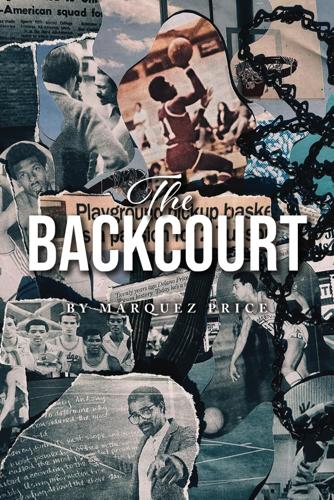“Arizona Friend Trips: Stories from the Road“ by Lisa Schnebly Heidinger and Julie Morrison. The University of Arizona Press. 224 pages. $24.95 paperback, $24.99 e-book.
“If I were told that the world would be destroyed except for one place that I got to choose,” writes Lisa Schnebly Heidinger in “Arizona Friend Trips,” “I’d keep Flagstaff.”
Yeah, me too. But there are other possible Arizona contenders that she and her friend, poet Julie Morrison, introduce us to in this feast of a road trip around the state.
Call it travel tapas. Each entry, one poem (Morrison) and a couple of photographs and a short essay (Heidinger): distinctive impressions, memories and descriptions of places one or the other has loved and wants to offer up to taste — short and sweet. Or savory.
Author and former news reporter Heidinger, and poet and former rancher Morrison, both from pioneer Arizona families but from different parts of the state, bring different perspectives. They clearly enjoy each other’s company, and their variations entertain.
Arranged geographically, the sites represent a vague circle of Arizona: From the North Rim of the Grand Canyon, they head northeast to Navajo lands, east to the White Mountains and Clifton south to Patagonia and Sonoita, they meander clockwise, with shots into the center to Tucson and Phoenix, wend west to Havasu, northwest through Prescott and finish in the Flagstaff area and the South Rim.
Tucson’s Arizona Inn gets a shoutout. As does El Tiradito.
A third presence joins the women in the book — Heidinger’s father’s Larry Schnebly (the late KGUN TV personality), from whom Heidinger claims to having inherited the “red-setter” (eager to jump into any car and go) gene, and with whom she visited many of these places. (Larry Schnebly on aging: “It’s tough movin’ west.”)
“Whether for the first time or to repeat trips past, /” writes Morrison, “we road-tripped to places still shaping our maps.”
Like any thoughfully prepared meal, this road trip is a gift.
— Christine Wald-Hopkins
“The Backcourt“ by Márquez Price. Independently published. 341 pages. $9.99.
Poet and essayist Márquez Price has often acknowledged in his writing the influence of his father, Tucson educator Delano Price.
In “The Backcourt,” he focuses on Delano’s life in the context of family, African-Americans in Tucson, local basketball and the life paths of Delano and his lifelong friend and co-basketball legend Wallace “Hoegie” Simmons.
Opening with some of his family’s history, Price then introduces the real subject of this book, the power of family values and basketball to shape lives, and to Delano and Hoegie.
Delano Price first became aware of the feared “Hoegie Wolf” when they were rising basketball stars as freshmen at Tucson and Pueblo High Schools, respectively.
As opposed to Delano’s stable, disciplined demeanor, Hoegie’s temperament was undisciplined and fiery. But Hoegie transferred to Tucson High, and by their junior year, the two had become a domineering backcourt duo. Both small guards, Delano excelled in the perfect lay-up; Hoegie, in speed, dexterity and an amazing ability to leap.
Price highlights Tucson High’s run to the 1969 state championship (by 2024 still not repeated), the post-high school basketball careers of Delano and Hoegie, and the directions in which their lives diverged.
A real treat of this book is his meticulous depiction of the two and Tucson basketball in the b-ball frenzy of the ‘70s, with Fred Snowden, Sean Elliot, Eric Money, et al. Supplemented by photos and stats, this is Price’s best writing in the book.
“The Backcourt” is not to be missed by longtime Tucsonans. This reviewer’s copy is on its way to a particular son who might well have learned painful lesssons from these two at ‘round-town pick-up games.
— Christine Wald-Hopkins
“I Know What UFO Did Last Summer“ by Kevin Garone. Timor Press. 206 pages. $19.99 hardback, $12.99 paperback, $8.99 e-book.
There’s just nothing like a good extraterrestrial invasion guidebook to keep you on your toes. And 12-year-old Marvin wouldn’t leave home without his.
The day a “man” and his “daughter” (clearly space aliens assuming human forms) move in next door to Marvin, they meet criteria of Byleth X. Congo’s “How to Survive an Alien Invasion: Your Guidebook to an Inevitable Future”: They are secretive and they have a bunch of electronic equipment. When Marvin, his best friend Jace — plus the girl, who follows them — discover a large, cylindrical vessel crashed in the woods behind their homes, they know Earth is under attack and they need to mount a defense.
Of course, it won’t be space aliens they need to mount a defense against.
Fun (“I would never betray the Earth to aliens,” Marvin insists. “But if I was forced to sacrifice something to save the planet, I wouldn’t mind giving them my siblings.”), “I Know What UFO Did Last Summer” is an engaging pre-teen read — even for reluctant readers. And their grandmothers.
— Christine Wald-Hopkins
“Book of iiwii: It is what it is. Is it what it is?“ by Kathy Lewis Sawyer. Wheatmark. 190 pages. $30.73, $15.05 paperback, $9.99 Kindle.
An unfamiliar acronym may seem, at first, a curious choice for a book title. But in fact, it was a carefully arrived-at decision, and as author Kathy Lewis Sawyer demonstrates in this enlightening book, she knows a thing or two about making decisions.
The acronym in question, iiwii (pronounced ee-wee), is shorthand for “It is what it is,” a familiar sentiment that’s the hallmark of Sawyer’s approach to facing circumstances that are beyond one’s control.
In well-researched chapters with instructive titles such as “Acceptance,” “Do Nothing,” and “Embrace Mystery,” she conveys valuable lessons about coping with class and going with the flow.
But that’s only half the story. Sometimes doing nothing is not the best decision. So, she flips her philosophy — and her book — on its head (literally), and turns the title into a question to examine the other side of iiwii: “Is it what it is?” The result is an invitation to question and take positive action when life hands you lemons.
Sawyer blends deep analysis with personal experiences and insights that illustrate her talking points and chart her personal growth. She’s a gifted storyteller — smart, articulate and funny — so there’s nothing didactic or finger-wagging about her approach to achieving a balanced life. Rather, there’s an intimacy to her delivery that feels warm and natural, like an old friend with some good advice, and her book is both a pleasure and a comfort to read.
Sawyer, who lives in Tucson, spent her career working for corporate and nonprofit organizations, and now dedicates herself to owning a business, art and writing.
— Helene Woodhams
“Guess What Happened While You Were Gone“ by Nancy H. Marks. Illustrated by Jessica Warrick. Missing Piece Press, LLC. 40 pages. $16.95.
The arrival of a pet-sitter is unsettling news to the quartet of dogs left behind while their owners vacation. Her luggage and a case of Diet Coke must surely mean the pet-sitter plans a lengthy stay. Worse, she doesn’t look like she knows how to cook. But, happily, the pet-sitter is generous with treats and attentive to a hurt paw. And with some canine urging, dinner arrives on time — at least until a mouse upsets the kitchen. Wouldn’t their vacationing owners want to know these things?
Twenty years ago, when author Nancy Marks was called on to pet-sit for some friends, she wrote a letter to let them know about the rich inner lives of their fur babies.
The letter resurfaced recently, she says, and it still makes her laugh, a gift she shares in this delightful picture book. With charming illustrations by Jessica Warrick, this is perfect for a read-aloud.
Marks lives in Tucson and, at age 80, this is her first book.
— Helene Woodhams
“The Time Golem: A Novelette“ by Seth Schindler. ELJ Publications. 54 pages. $10. $8 Kindle.
At Tucson’s hippest art gallery in the gentrified Barrio Santa Rosa, sculptor David Klein unveils a one-man show. The buzzy centerpiece is a golem, a piece so large that there’s some question about whether it will even fit through the door.
In Jewish lore, a golem is a kind of Frankenstein monster, a creature made of clay or mud and animated through a mystical incantation. Golems are meant to offer protection but are known to be unpredictable.
It was a puzzling creative choice for David, but the Holocaust survivor’s life has taken surprising turns before. Breathing life into his creation may be its most inexplicable turn yet.
With “The Time Golem,” author Seth Schindler offers a thoughtful contemplation on salvation, peace and the elusive nature of memory. It’s a deeply satisfying read.
Schindler, who lives in Tucson, is an anthropologist, sculptor, Zen archer and writer of fiction and non-fiction. The University of Arizona Press recently published his book on food insecurity, “Sowing the Seeds of Change.”
— Helene Woodhams
“What Color Is Your Hand? ¿De Qué Color Es Tu Mano?“ by Roni Capin Rivera-Ashford. Illustrated by Walter Thompson. Archway Publishing. 46 pages. $18.99. $14.99 paperback. $7.99 Kindle.
“Like the rainbow after a storm, the world needs every color to be beautiful and complete.”
In this luminous, bilingual picture book, a wise grandmother who “thinks with her heart,” tenderly helps her troubled grandson imagine a future without prejudice and bullying, one in which all people are cherished for their differences.
It’s a beautifully-rendered and deeply-felt story that exudes warmth as it celebrates the important bond between a grandma and her mijo, a safe haven in a complicated world.
It’s no surprise that this delightful work comes from the prolific pen of award-winning Tucson author Roni Capin Rivera-Ashford, a writer with a gift for engaging young readers and inspiring adults.
It’s especially touching that Rivera-Ashford dedicates this book about hope and acceptance to the memory of Gabriel Zimmerman, Congresswoman Gabby Giffords’s young congressional aide, who lost his life in a tragic shooting incident in Tucson in 2011. Zimmerman was known for his ability to bring people together, and by channeling his voice, Rivera-Ashford makes this story all the more meaningful.
Brilliant artwork by Tucson illustrator Walter Thompson rounds out this superior volume, which belongs on every child’s bookshelf.
— Helene Woodhams
Christine Wald-Hopkins, a former high school and college English teacher and occasional essayist, has long been a book critic for national, regional and local newspapers.
Helene Woodhams is retired from Pima County Public Library, where she was the literary arts librarian.
If you are a Southern Arizona author and would like your book to be considered for this column, send a copy to: Elaine Encinas, P.O. Box 26887, Tucson, AZ, 85726-6887. Give the price and contact name. Books must have been published within a year. Authors may submit no more than one book per calendar year.













